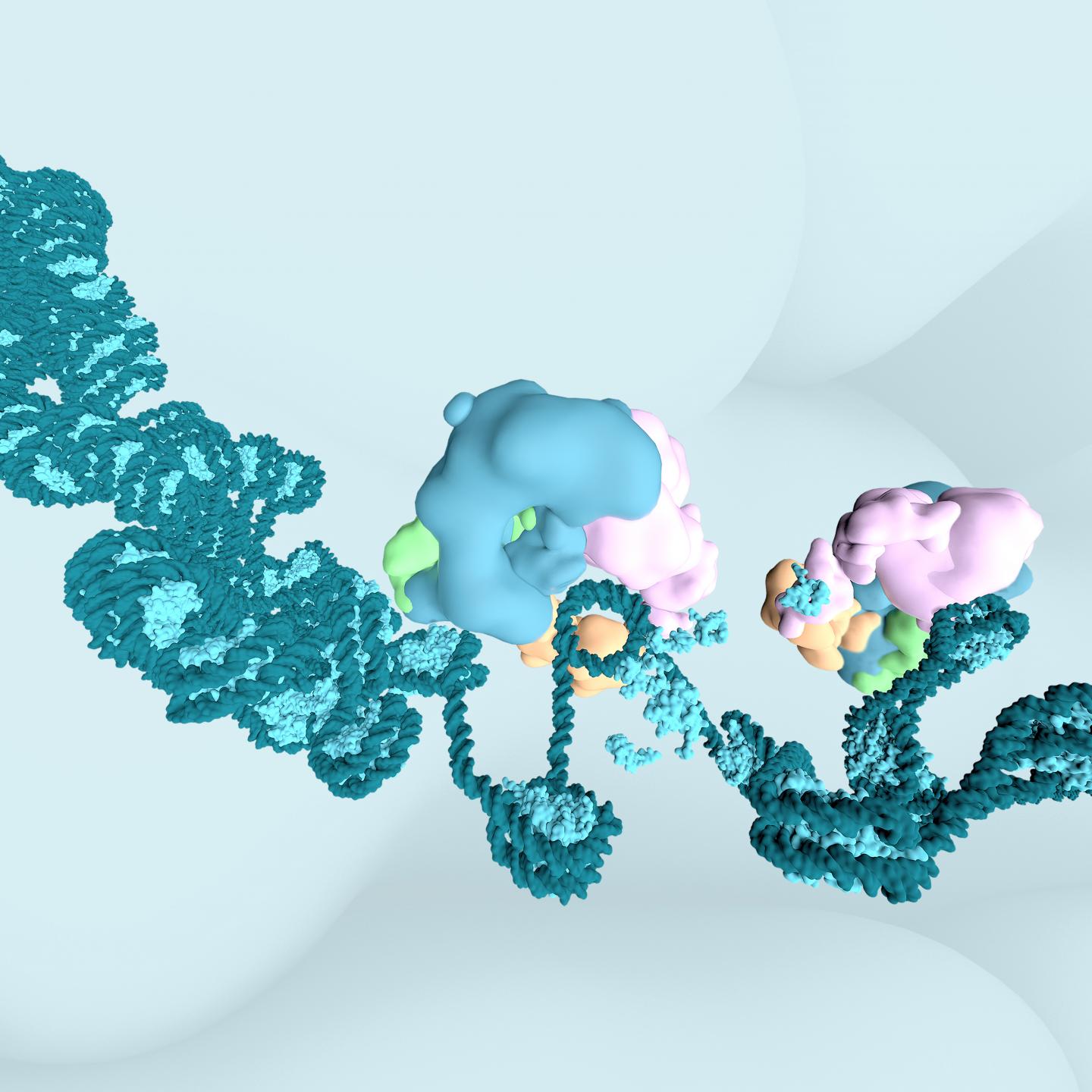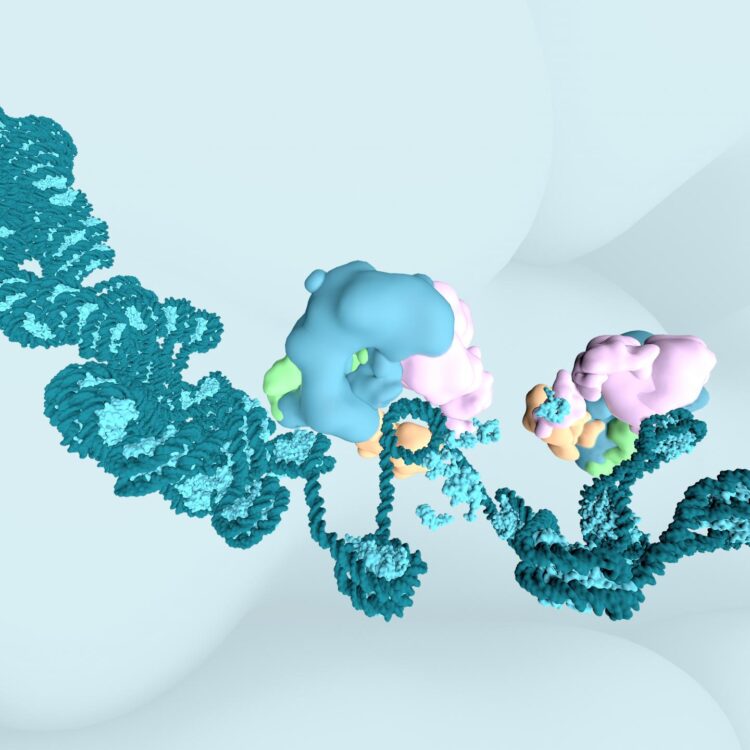
Credit: Bobby Rajesh Malhotra_CeMM
When human cells have to adapt due to a wide variety of external influences, the BAF complex plays a central role because it controls the accessibility of the DNA and thus the information stored in it. In every fifth human cancer, a mutation is found in one of the BAF complex genes. Scientists from the research group of Principal Investigator Stefan Kubicek at the CeMM Research Center for Molecular Medicine of the Austrian Academy of Sciences have investigated this complex in more detail using novel techniques and were able to show how quickly changes in the BAF complex genes influence the accessibility of DNA. The study has now been published in Nature Genetics.
Chromatin is a central component of the cell nucleus and refers to the material that makes up the chromosomes. It organizes the approximately two meters of human DNA in such a way that certain genes are activated or deactivated depending on the cell type. The smallest “packaging unit” of chromatin is the nucleosome, consisting of 146 base pairs of DNA wrapped around a histone octamer. Whenever cells need to adapt, for example due to environmental influences or developmental signals, corresponding changes to chromatin are necessary. These are carried out by various enzymes, including chromatin remodeling complexes, which use the energy of adenosine triphosphate (ATP) to move nucleosomes along the DNA or to remove them completely. One important chromatin remodeling complex is the BAF complex. It consists of up to 14 subunits encoded by 29 genes which interact in different combinations. Previous studies have found mutations in certain subunits of the BAF complex in numerous cancers. In their recently published study, CeMM Principal Investigator Stefan Kubicek and his research group investigated the direct effects of changes in the BAF complex on DNA accessibility.
Faster than the cell cycle
In order to observe the functions of chromatin remodeling complexes, commonly genetic methods are used which can inactivate these proteins within 3-5 days. However, due to the slowness of these technologies, they were hardly suited to determine the immediate effects of changes to the BAF complex on DNA accessibility. Therefore, the scientists Sandra Schick, Sarah Grosche and Katharina Eva Kohl from Kubicek’s research group relied on a so-called degron system. “Here, too, we use CRISPR genome editing. But instead of destroying a BAF subunit, we fuse it with a small protein called a ‘dTag’. By adding a specific active substance, we can then recruit the ‘dTag’-tagged subunit to components of the cellular ‘waste removal’. The labelled BAF subunit is then degraded within one hour. This makes it possible to precisely observe whether and how accessibilities subsequently change,” explain the study authors. Stefan Kubicek adds: “Our study has shown that removing a specific subunit of the BAF complex immediately leads to a loss of accessibility to certain DNA regions. The effect appears immediate, hinting that the cell cycle plays no role in this process. We were also able to confirm these results with pharmacological inhibitors of the BAF complex, which showed particularly fast effects. We assume that processes similar to those in our model system also play a role in carcinogenesis when mutations of a subunit of the BAF complex occur in cells for the first time.”
Synthetic lethality amplifies effect
In earlier studies, Kubicek’s research group had already investigated how different genes within the BAF complex interact. This showed that cells in which only a certain BAF subgroup has a mutation and reduces DNA accessibility can continue to live and grow. In some cases, however, the additional deactivation of another, specific subgroup leads to cell death. This interaction of specific genes is called synthetic lethality. A known synthetic lethality exists in the two genes SMARCA2 and SMARCA4. Cells can tolerate the loss of either of these genes but die as soon as both are mutated. Mutations of SMARCA4 have been found to be particularly common in cancer cells. Specific SMARCA2 inhibition has the potential to exploit synthetic lethality to specifically kill these SMARCA4-mutated cancer cells without damaging healthy cells. In their current study, the study authors observed the immediate effects of synthetic lethality. “We wanted to know what happens when we remove both subunits,” says study author Sandra Schick. This showed that compared to the loss of each individual subunit, even more regions of the DNA lose accessibility, especially those that are crucial for cell identity. “We see that so-called ‘super-enhancers’, very active gene regulatory regions, only lose their accessibility when we trigger this synthetic lethality, i.e. lose both SMARCA4 and SMARCA2.”
BAF complex needs constant activity
In addition, the scientists tried to trigger the same effect using pharmacological substances. These inhibit the activity of the BAF complex and prevent it from moving nucleosomes. Project leader Stefan Kubicek explains: “Our results show that maintaining the accessibility of BAF-controlled sites in the genome requires constant ATP-dependent remodeling. This means that the BAF complex needs constant energy provided by ATP to move nucleosomes and thus maintain access to the DNA. Complete abrogation of the BAF complex function results in a near-total loss of chromatin accessibility at BAF-controlled sites.”
###
The study „Acute BAF perturbation causes 1 immediate changes in chromatin accessibility” was published in Nature Genetics, on 8. February 2021. DOI: 10.1038/s41588-021-00777-3
https:/
Authors: Sandra Schick*, Sarah Grosche*, Katharina Eva Kohl*, Danica Drpic, Martin G. Jaeger, Nara C. Marella, Hana Imrichova, Jung-Ming G. Lin, Gerald Hofstätter, Michael Schuster, André F. Rendeiro, Anna Koren, Mark Petronczki, Christoph Bock, André C. Müller, Georg E. Winter, Stefan Kubicek
*shared first-authorships
Funding: The study was conducted within the framework of the Christian Doppler Laboratory for Chemical Epigenetics and Antiinfectives in collaboration with Boehringer Ingelheim. The study was supported by the Austrian Federal Ministry for Digital and Economic Affairs and the National Foundation for Research, Technology, and Development, the Austrian Science Fund (FWF) F4701 and the European Research Council (ERC) under the European Union’s Horizon 2020 research and innovation programme (ERC-CoG-772437). Christoph Bock is supported by an ERC Starting Grant (European Union’s Horizon 2020 research and innovation programme, grant agreement no. 679146). Sarah Grosche is supported by the Peter and Traudl Engelhorn Foundation.
Stefan Kubicek joined CeMM in August 2010. He obtained an MSc in synthetic organic chemistry from the Vienna University of Technology after writing a diploma thesis at ETH Zurich. For his PhD in Thomas Jenuwein’s lab at the IMP in Vienna, he changed fields to molecular biology. He then performed postdoctoral research working on chemical biology with Stuart Schreiber at the Broad Institute of Harvard and MIT. Stefan Kubicek heads the chemical screening platform and PLACEBO (Platform Austria for Chemical Biology), a task he is well equipped for based on previous screening experience with Boehringer Ingelheim and at the Broad Institute. Stefan Kubicek has also headed the Christian Doppler Laboratory for Chemical Epigenetics and Antiinfectives, a public-private partnership between CeMM, Boehringer Ingelheim and Haplogen. The Kubicek lab is working on the role of chromatin in the definition of cell types and cell states, particularly chromatin modifying enzymes as synthetic lethal targets in cancer and chemical transdifferentiation to insulin-producing beta cells. In an ERC-funded project, the laboratory is working on metabolic enzymes in the cell’s nucleus and testing the hypothesis that small molecule metabolites shape chromatin structure and thus control gene expression and cell identity.
The mission of CeMM Research Center for Molecular Medicine of the Austrian Academy of Sciences is to achieve maximum scientific innovation in molecular medicine to improve healthcare. At CeMM, an international and creative team of scientists and medical doctors pursues free-minded basic life science research in a large and vibrant hospital environment of outstanding medical tradition and practice. CeMM’s research is based on post-genomic technologies and focuses on societally important diseases, such as immune disorders and infections, cancer and metabolic disorders. CeMM operates in a unique mode of super-cooperation, connecting biology with medicine, experiments with computation, discovery with translation, and science with society and the arts. The goal of CeMM is to pioneer the science that nurtures the precise, personalized, predictive and preventive medicine of the future. CeMM trains a modern blend of biomedical scientists and is located at the campus of the General Hospital and the Medical University of Vienna. http://www.
Media Contact
Anna Maria Schwendinger
[email protected]
Original Source
http://cemm.
Related Journal Article
http://dx.





